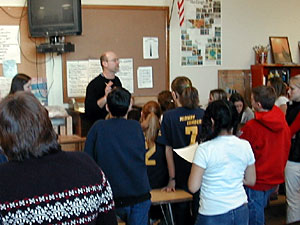|
Audio
Photos
Your Voice
|
The teachers' view
March 10, 2003
 |
| Hermantown middle school art teacher Tom Rauschenfels explains print making to 8th graders (MPR Photo/Dan Olson) |
St. Paul, Minn. — The 8th graders in Tom Rauschenfels' Hermantown middle school art class cut the chatter once they see the tall, bespectacled educator waiting for their attention. By the new federal standards, Rauschenfels is a highly qualified teacher. His college major and certification are in the subject area he's teaching.
The No Child Left Behind act specifies that a high quality teacher has a college degree in the topic area being taught. New teachers coming out of college must meet that requirement and pass a test to show they know the material they seek a license to teach.
 | |||
The act does not address other characteristics Tom Rauschenfels says are an everyday part of being an educator.
"We are asked to be social worker, we are asked to get involved in the students life outside of our subject area just to kid that kid in our classroom," he says, "We have to play policeman once in awhile and fill that youngsters void that maybe isn't coming from parents, that maybe isn't coming from anywhere else in their life."
The high quality teacher standard sounds like common sense. Meeting it, however, will be a tall order.
Millions of American school children are being taught, legally for now, by people whose college degrees or teacher certification aren't in the subject they're teaching. In some of this country's most distressed schools students are being taught by teachers who failed minimum competency tests.
Minnesota's commissioner of Children Families and Learning, Cheri Pierson Yecke, helped write the No Child Left Behind law while at the federal Department of Education. She says the shortage of people who meet the high quality standard is most evident in middle schools and in math and science classrooms. "In eighth grade math teachers," Yecke says, "only forty one percent have majored in math. In terms of whose going to be most impacted by the teacher quality component of the law it would be existing middle school teachers because in many instances they've been allowed to get a middle school credential which is sort of generalist degree."
Minnesota middle school teachers are college grads who've taken college classes in the areas they teach. However, state officials don't know how many don't have a college major in the area they're teaching.
The Minnesota Board of Teaching is writing rules for meeting the high quality teacher requirement. Board of Teaching Executive Director George Maurer says Minnesota's rural school districts will have a tough time meeting the standard. Some educators there are granted waivers to teach out of their area of study because of the shortage, for example, of math and science teachers. Even so, Maurer says ninety-three percent of Minnesota's educators are teaching subjects they know. He says Minnesota will have a much easier time complying with the federal law than other states. "We are number one in the nation for teachers teaching in their content. So we're talking about seven percent of the teachers that currently are not able to be listed as highly qualified," Maurer says.
Many other states have relaxed licensing requirements to cope with a shortage of qualified teachers.
The shortage is exacerbated by a wave of retirements, difficult working conditions and low entry level pay.
|
Bringing the secondary school down to the fifth grade and then having subject matter specialists is a fundamental change in the way we've taught about schooling for that middle range of students.
- David Imig |
Experts predict we'll need 2 million more teachers nationwide this decade to meet demand.
Making sure they meet the high quality teacher requirement will likely cause a major shift in how educators are trained and certified.
David Imig says a popular middle school philosophy these days is to train educators to teach across subject areas. Imig is president of the Washington, D. C.- based AACTE, the American Association of Colleges for Teacher Education. The organization represents 750 universities and colleges. A middle school social studies teacher, for example, might blend teaching history with writing skills or english literature. "What we've done is we've tended to think of subject generalists," Imig says, "people who have a range of experiences in those subjects and then certified them to teach a number of different courses."
People who don't like the generalist approach say students, especially those in middle schools, need to learn more in core areas. They favor the high school model where teachers with specific training teach single subject courses. Imig says meeting the high quality teacher requirement will encourage schools to hire specialists. "So if you will, bringing the secondary school down to the fifth grade," Imig says, "and then having subject matter specialists is a fundamental change in the way we've taught about schooling for that middle range of students.
Meeting the high quality teacher standard lays the groundwork for another controversial change in the way teachers are trained and licensed.
There's growing support to allow professionals who haven't been trained as educators into the classroom. An engineer, for example, who can pass a test measuring math knowledge would be certified to teach math with little, if any, teacher training. The No Child Left Behind act endorses the concept.
However, skeptics abound. They ask, for example, how class size affects high quality teaching?
 | |||
Supporters point to dramatic test score gains in schools where the law's requirements are in place. The examples include classrooms where the class size is 18, much smaller than many American schools and much more expensive than many taxpayers are willing to support. Hermantown middle school English teacher Dina Post says class size is an important factor affecting how well teachers and students perform. "The biggest class I ever had was 38 in another school district," Post says, "and the smallest was a class of 20 and there's so much more you can do with that class of 20 because in a class of 20 no child is left behind because you recognize every child and they don't kind of fall through the cracks."
No Child Left Behind skeptics have other questions. How do forces outside the classroom such as poverty and parent involvement affect high quality teaching? Hermantown middle school principal Ellen Wiss says the No Child Left Behind law holds schools accountable for factors they can't control. "Until we can find a way to make schools responsibile for those they should be responsible for and every other part of society be responsibile for those things that they are best equipped to take care of, " Wiss says, "then it's always going to be a struggle, it's always going to be that they're doing something to us, or putting something on us instead of that partnership."
School districts are more than a little anxious about where money will be found to meet No Child Left Behind requirements. Supporters say President Bush's proposal for $53 billion dollars in federal education spending will help districts pay for the additional testing, tutoring, staff development and other expenses created by the act. Others say the money is a fraction of what's needed to meet the law's requirements.
|
News Headlines
|
Related Subjects
|

